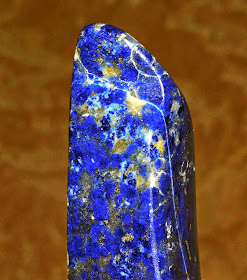FACETED CLINOHUMITE, TAJIKISTAN
Clinohumite is an uncommon member of the humite group, a magnesium silicate according to the chemical formula(Mg,Fe)9(SiO4)4(F,OH)2. The formula can be thought of as four olivine (Mg2SiO4), plus one brucite (Mg(OH)2). Indeed, the mineral is essentially a hydrated olivine and occurs in altered ultramafic rocks and carbonatites. Most commonly found as tiny indistinct grains, large euhedral clinohumite crystals are sought by collectors and occasionally fashioned into bright, yellow-orange gemstones. Only two sources of gem-quality material are known: the Pamir Mountains of Tajikistan, and the Taymyr region of northern Siberia. It is one of two humite group minerals that have been cut into gems, the other being the much more common chondrodite.
EMERALD FROM MUZO MINES, COLOMBIA
Emerald is a gemstone and a variety of the mineral beryl (Be3Al2(SiO3)6) colored green by trace amounts of chromium and sometimes vanadium. Beryl has a hardness of 7.5–8 on the Mohs scale. Most emeralds are highly included, so their toughness is classified as generally poor.
LAPIS LAZULI, AFGHANISTAN
Lapis lazuli is a deep blue semi-precious stone that has been prized since antiquity for its intense color. Lapis lazuli is a rock whose most important mineral component is lazurite (25% to 40%), a feldspathoid silicate mineral with the formula (Na,Ca)8(AlSiO4)6(S,SO4,Cl)1-2. Most lapis lazuli also contains calcite (white), sodalite (medium blue), and pyrite (metallic yellow). Other possible constituents: augite; diopside; enstatite; mica; hauynite; hornblende, and nosean. Some lapis lazuli contains trace amounts of the sulfur-rich löllingite variety geyerite.
LIDDICOATITE - A VARIETY OF TOURMALINE FROM ANJANABONOINA PEGMATITES, MADAGASCAR
Fluor-liddicoatite is a rare member of the tourmaline group of minerals, elbaite subgroup, and the theoretical calcium end member of the elbaite-fluor-liddicoatite series; the pure end-member has not yet been found in nature. Fluor-liddicoatite is indistinguishable from elbaite by X-ray diffraction techniques. It forms a series with elbaite and probably also with olenite. Liddiocoatite is currently a non-approved mineral name, but Aurisicchio et al. (1999) and Breaks et al. (2008) found OH-dominant species. Formulae are
- Fluor-liddicoatite Ca(Li2Al)Al6(BO3)3Si6O18(OH)3F
- Elbaite Na(Al1.5Li1.5)Al6(BO3)3Si6O18(OH)4
- Olenite NaAl9B3Si6O27O3(OH)
Fluor-liddicoatite was named in 1977 after Richard T. Liddicoat (1918–2002) gemmologist and president of the Gemological Institute of America, who is well known for introducing the GIA diamond grading system in 1953.
WONDERFUL CRYSTAL OF UVAROVITE OVER 8 MM, FROM OUTOKUMPU MINE, FINLAND
Uvarovite is a chromium-bearing garnet group species with the formula: Ca3Cr2(SiO4)3. It was discovered in 1832 by Germain Henri Hess who named it after Count Sergei Semenovitch Uvarov (1765–1855), a Russian statesman and amateur mineral collector. Uvarovite is one of the rarest of the garnet group minerals, and is the only consistently green garnet species, with an emerald-green color. It occurs as well-formed fine-sized crystals.
RUBY FROM MOGOK
A ruby is a pink to blood-red colored gemstone, a variety of the mineral corundum (aluminium oxide). The red color is caused mainly by the presence of the element chromium. Its name comes from ruber, Latin for red. Other varieties of gem-quality corundum are called sapphires. The ruby is considered one of the four precious stones, together with the sapphire, the emerald and the diamond.
BENITOITE CRYSTALS FROM SAN BENITO, UNITED STATES
Benitoite is a rare blue barium titanium silicate mineral, found in hydrothermally altered serpentinite. Benitoite fluoresces under short wave ultraviolet light, appearing bright blue to bluish white in color. The more rarely seen clear to white benitoite crystals fluoresce red under long-wave UV light. It was first described in 1907 by George D. Louderback, who named it benitoite for its occurrence near the headwaters of the San Benito River in San Benito County, California. Benitoite occurs in a number of sites, but gemstone quality material has only been found in California. In 1985 benitoite was named as the official state gem of California. Benitiote has a rare 5 pointed crystal form, and an even rarer 6 pointed form, "star of David", with about 24 samples known.
RED BERYL, WAH WAH MOUNTAINS IN UTAH, UNITED STATES
Beryl is a mineral composed of beryllium aluminium cyclosilicate with the chemical formula Be3Al2(SiO3)6. The hexagonal crystals of beryl may be very small or range to several meters in size. Terminated crystals are relatively rare. Pure beryl is colorless, but it is frequently tinted by impurities; possible colors are green, blue, yellow, red, and white.
TANZANITE CRYSTALS OF EXCEPTIONALLY HIGH QUALITY, FROM MERELANI HILLS IN TANZANIA
Tanzanite is the blue/violet variety of the mineral zoisite (a calcium aluminium hydroxyl Sorosilicate) belonging to the epidote group. It was discovered in the Mererani Hills of Manyara Region in Northern Tanzania in 1967, near the city of Arusha and Mount Kilimanjaro. Tanzanite is used as a gemstone, and naturally-formed tanzanite is extremely rare, still found only in the Mererani Hills. Tanzanite is noted for its remarkably strong trichroism, appearing alternately sapphire blue, violet and burgundy depending on crystal orientation. Tanzanite can also appear differently when viewed under alternate lighting conditions. The blues appear more evident when subjected to fluorescent light and the violet hues can be seen readily when viewed under incandescent illumination. Tanzanite is usually a reddish brown in its rough state, requiring artificial heat treatment to bring out the blue violet of the stone.
Photo Courtesy: The Arkenstone
Photo Courtesy: The Arkenstone








